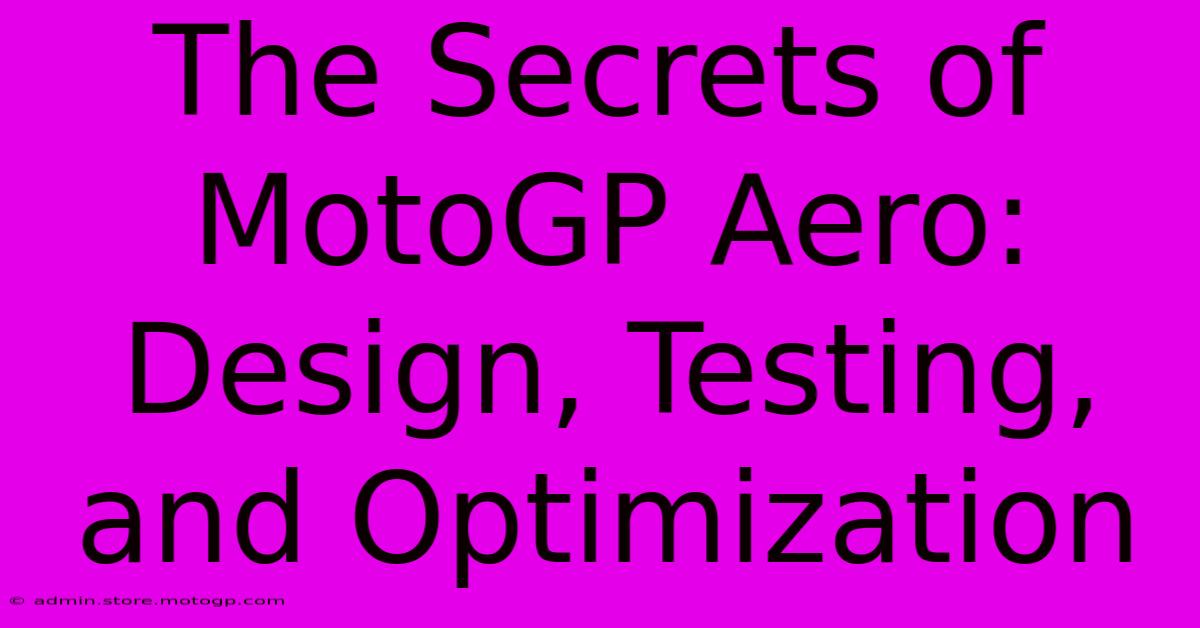The Secrets Of MotoGP Aero: Design, Testing, And Optimization

Table of Contents
The Secrets of MotoGP Aero: Design, Testing, and Optimization
MotoGP, the pinnacle of motorcycle racing, is a relentless pursuit of speed and performance. A crucial element contributing to a rider's success isn't just raw horsepower or impeccable riding skill; it's the sophisticated aerodynamics meticulously crafted into the machines. This article delves into the secrets behind MotoGP aero, exploring the design, rigorous testing processes, and continuous optimization that pushes the boundaries of motorcycle aerodynamics.
Understanding the Importance of Aerodynamics in MotoGP
The speeds achieved in MotoGP are phenomenal, generating significant aerodynamic forces. These forces, if not managed effectively, can drastically impact stability, handling, and ultimately, lap times. Aerodynamic packages aren't just about adding wings; they're about carefully balancing downforce, drag, and airflow to create a competitive edge. Downforce keeps the bike planted to the track at high speeds, improving cornering and braking stability. Drag, on the other hand, resists forward motion, thus reducing top speed. The challenge lies in maximizing downforce while minimizing drag – a delicate balancing act that requires cutting-edge technology and expertise.
Key Aerodynamic Components
Modern MotoGP bikes are equipped with a complex array of aerodynamic components:
-
Wings: These are perhaps the most visible elements, generating downforce on the front and rear. Their design is constantly evolving, with teams experimenting with different shapes, sizes, and configurations to optimize performance in various track conditions. Winglet designs have been particularly crucial in recent years, offering refined control over airflow.
-
Fairings: The fairing, the bodywork encasing the engine and other components, is carefully sculpted to manage airflow around the bike. Computational Fluid Dynamics (CFD) is heavily used in designing the fairing's shape to minimize drag and direct airflow effectively.
-
Underbody Aerodynamics: The underside of the bike plays a significant role in generating downforce. Teams employ various techniques, such as diffusers and carefully shaped underbody panels, to manage airflow and create a ground-effect phenomenon, further enhancing grip.
-
Air intakes and exhausts: The positioning and design of air intakes and exhausts are crucial to engine cooling and performance. These elements must be optimized for aerodynamic efficiency, ensuring effective cooling without adding significant drag.
The Testing and Optimization Process: A Continuous Evolution
Developing and optimizing MotoGP aerodynamics isn't a one-time process; it's a continuous cycle of design, testing, and refinement. Teams employ a range of sophisticated techniques:
1. Computational Fluid Dynamics (CFD): Virtual Wind Tunnels
CFD uses complex computer simulations to model airflow around the bike. This allows engineers to virtually test different designs and configurations, identifying areas for improvement before ever building a physical prototype. CFD analysis is a crucial tool in optimizing various parameters like downforce, drag, and yaw stability.
2. Wind Tunnel Testing: Real-World Validation
While CFD provides valuable insights, wind tunnel testing is essential to validate the simulations and fine-tune the design. Teams use sophisticated wind tunnels capable of replicating race conditions to measure aerodynamic forces and airflow patterns precisely. Wind tunnel testing helps identify unexpected interactions between different components and fine-tune the design for optimal performance.
3. Track Testing: The Ultimate Proof
The ultimate test of any aerodynamic design is on the track itself. Teams collect telemetry data during testing sessions, providing valuable insights into the aerodynamic performance of the bike under actual race conditions. This allows for adjustments and fine-tuning to fully optimize the package. Telemetry data analysis reveals the strengths and weaknesses of the design, guiding further improvements.
The Future of MotoGP Aero: Innovation and Competition
The pursuit of aerodynamic perfection in MotoGP is a constant race. Teams are continually pushing boundaries, experimenting with new materials, and developing innovative designs. The future of MotoGP aero likely includes even more sophisticated CFD simulations, advanced wind tunnel testing, and the integration of active aerodynamic elements – creating a truly dynamic and responsive aerodynamic package capable of reacting to changing track conditions. The quest for that ultimate edge, measured in fractions of a second, ensures that the field will remain as competitive and innovative as ever.
Keywords: MotoGP, aerodynamics, downforce, drag, wings, winglets, fairing, underbody aerodynamics, CFD, wind tunnel testing, telemetry, optimization, design, testing, motorsports, motorcycle racing, lap times, performance, competition, innovation.

Thank you for visiting our website wich cover about The Secrets Of MotoGP Aero: Design, Testing, And Optimization. We hope the information provided has been useful to you. Feel free to contact us if you have any questions or need further assistance. See you next time and dont miss to bookmark.
Featured Posts
-
Best Motorcycle Racing Essential Safety Gear Checklist
Feb 19, 2025
-
The Art Of Passing Best Motorcycle Racing Overtaking Techniques
Feb 19, 2025
-
The Ultimate Guide To Moto Gp Bike Costs
Feb 19, 2025
-
The Greatest Moto Gp Rider A Legacy Defined
Feb 19, 2025
-
Mastering F1 Ratings
Feb 19, 2025
